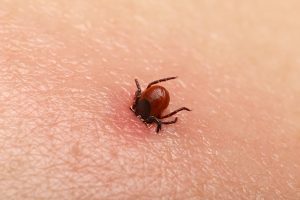Did you know that a tick bite can sometimes cause facial paralysis? Dr. Nate Jowett of the Facial Nerve Center at Mass. Eye and Ear breaks down Lyme disease associated-facial palsy — and what you need to know to make sure you get the right treatment.
Ticks are those small, pesky bugs known for carrying Lyme disease, a bacterial infection transmitted through the bite of an infected tick. The CDC estimates that blacklegged ticks, or “deer ticks,” infect more than 300,000 Americans with Lyme disease each year.
“Lyme disease is prevalent in New England, and it can be challenging to diagnose,” said Nate Jowett, MD, a specialist in the Facial Nerve Center at Mass. Eye and Ear. “It’s important for those at risk to know the potential symptoms — especially those who venture into wooded or grassy areas.”
Signs of Lyme Disease
Lyme disease symptoms may begin anywhere from days to weeks following exposure and often vary greatly between individuals. Many patients do not even recall being bitten by a tick.
The most common symptom is a target-like rash that moves around the body. However, many patients do not notice or develop a rash. In these cases, laboratory testing is needed for a diagnosis.
Other symptoms might include fever, chills, headache, fatigue, neck stiffness or muscle aches. In late stages, some patients also develop arthritis.
Because Lyme disease is caused by bacteria that can affect the nervous system, it can sometimes cause dysfunction of the facial nerve (the nerve that controls how we move our face to smile, pucker our lips, blink and more).
About five percent of patients with Lyme disease will develop some degree of sudden facial weakness (or “facial palsy”), where one or both sides of the face droop. Known as Lyme disease-associated facial palsy, this tends to occur seven to 21 days after tick exposure in infected patients. Anyone who experiences sudden facial palsy should be urgently assessed by a physician to establish the appropriate diagnosis.

Getting the Right Treatment
Lyme disease-associated facial palsy may look a lot like Bell’s palsy— another cause of sudden facial weakness. But the two conditions are not the same.
Though more research is needed, a recent study from Mass. Eye and Ear suggests that patients with Lyme disease-associated facial palsy might develop worse long-term outcomes when treated with the same regimen used to treat patients with Bell’s palsy.
Since Lyme disease is a bacterial infection, it requires antibiotic therapy. Bell’s palsy is believed to be caused by a virus, and therefore is typically treated with corticosteroids and antivirals.
“In some cases of acute facial palsy, physicians will prescribe antibiotics, corticosteroids and antiviral medications while awaiting lab results for Lyme disease,” said Dr. Jowett. “While good evidence supports the use of corticosteroids in Bell’s palsy, their role as an add-on therapy for Lyme disease-associated facial palsy is currently unclear.”
Patients with Lyme disease-associated facial palsy and Bell’s palsy often experience different symptoms:
- Patients with Bell’s palsy typically feel fine, whereas patients with Lyme disease-associated facial palsy often have flu-like symptoms. While changes in taste, ear pain and pain behind the ear occur frequently in both conditions, facial weakness that is accompanied by severe headaches, fever or chills, neck stiffness, severe fatigue or lethargy, back or abdominal pain or muscle aches is highly suggestive of Lyme disease.
- Bell’s palsy typically involves only one side of the face, whereas Lyme disease can involve one or both sides.
The Road to Recovering Facial Movement
Recovery of facial function often begins within a few weeks; however, it may take up to three to four months before some Lyme disease-associated facial palsy patients see any sign of recovery — and up to 18 months before recovery is complete.
While all patients with Bell’s palsy or Lyme disease-associated facial palsy should recover facial tone and movement on the affected side, some will develop permanent facial muscle tightness, involuntary facial movements (such as involuntary eye closure) or restricted smile excursion. These long-term side effects can be effectively treated through targeted physical therapy, Botox® injections or surgical procedures.
The Bottom Line
“Patients who live in tick-infested areas should focus on prevention while outdoors,” said Dr. Jowett. “They can reduce their risk of infection by wearing pants and long-sleeve shirts, using appropriate chemical repellants and performing meticulous daily skin checks. Those at risk should seek medical care if they develop a target-like rash, sudden facial weakness or flu-like symptoms during tick season.”
About Our Expert
 Nate Jowett, MD, FRCSC, is a facial plastic and reconstructive surgeon in the Facial Nerve Center at Mass. Eye and Ear, where he specializes in the care of patients with facial nerve disorders.
Nate Jowett, MD, FRCSC, is a facial plastic and reconstructive surgeon in the Facial Nerve Center at Mass. Eye and Ear, where he specializes in the care of patients with facial nerve disorders.
Hi, I have a question about Lyme disease. About a month ago, I had a tick biting. After two days My joint (near to the waist) leg has pain and now the region is numb. I searched on the internet that this is the peripheral neuropathy due to Lyme disease. So, what can I do for this problem? Is there any drug for the curring?
Hi Hamed, thanks for reading our blog and for your comment, and sorry to hear. We can’t give medical advice over the blog, but we do treat issues related to facial nerve paralysis and Lyme disease at our Facial Nerve Center, if you’d like to make an appointment. https://www.masseyeandear.org/specialties/facial-nerve-center
I was diagnosed with Bells Palsy from a tick bite. test positive for Lyme’s Disease
am taking Doxycycline for 21 days from the ER Doctor and no other meds.
I’ve been told I have to just wait for the palsy to go away, but is there something else I should be doing to help it along.
Hi Bonetti, thanks for reading and sorry to hear what you are going through. We can’t give medical advice over our blog, you can contact the Facial Paralysis Center for an appointment at 617-573-3641 and look at our website: https://www.masseyeandear.org/specialties/facial-nerve-center
Hi! I was bitten by a tick 4 weeks ago, realized it was Lyme 2 weeks ago and started to take antibiotics for 21 days (I been taking for 1.5 week so far)
Now im with face paralysis in the left side of my face. Do you have any recommendation? It is normal? How long should it take to recover?
Hi John, thanks for reading and sorry to hear about your facial paralysis. We can’t give medical advice over our blog, you can contact the Facial Paralysis Center for an appointment at 617-573-3641 and look at our website: https://www.masseyeandear.org/specialties/facial-nerve-center
Dr. Jowett,
Thank you for the information. I have read and reread it over the last 12 months and found it encouraging . I have facial paralysis from Lyme (July 2019). I was misdiagnosed and given steroids and antivirals. My paralysis did improve but I still have issues with my eye and some difficulty when speaking. Are there treatments that have shown to improve facial paralysis even after a period of time? I wasn’t successful in finding a doctor in my area that had experience in dealing with Lyme, even though Michigan has a healthy tick population. I want to make certain I have done everything possible to promote healing.
Thank you ,
Sherry
I would like to know recommended treatment for Lyme w/ facial neuropathy?
My daughter diagnosed with Bell’s Palsy from a tick bite. We are not in your area. What type of specialist should I see for her to get help. We live in the Pittsburgh area. What type of specialty would deal with this issue? I am not aware of an Eye and Ear group in the area, but not sure what the proper name of that specialty would be to look more intently.
Hi Lynn, thanks for your comment and sorry to hear. If it’s a program like ours, it would be someone in the Division of Facial Plastic and Reconstructive Surgery within the Department of Otolaryngology– Head and Neck Surgery. We can’t give specific medical advice otherwise over the blog, but if you’re interested in an appointment or virtual visit at Mass Eye and Ear, you can call 617-573-3223 and visit here: https://www.masseyeandear.org/specialties/facial-plastics
hi, when i was seven (nearly eight) I got a tick and so went to my GP, they didn’t think anything of it so after 2 appointments we decided to go to the hospital where i had blood tests and it came back positive for Lyme disease, I am now 15 and have not fully recovered with noticeable differences on the left side of my face. i have booked another appointment with my GP but didn’t know if there was something you could suggest to do as its been so long? thank you,
Hi Em, thanks for reading and your comment, we are sorry to hear what you’ve been experiencing. Unfortunately we can’t give medical advice over our blog, but you can make an appointment with one of our physicians who treats Lyme-related facial palsy for more info on whether anything can be done. https://www.masseyeandear.org/specialties/facial-plastics
I was diagnosed with Lyme Disease in the end of December. I’d had the rash for at least two months. Your article says that facial weakness associated with Lyme Disease happens on both sides of the face. This morning I noticed slight asymmetry in my smile and how open my eyes were. Do you have any thoughts?
Hi Emily, thanks for reading, unfortunately we can’t give medical advice over the blog and comment on a person’s specific symptoms or situation. Feel free to make an appointment with one of our specialists at our Facial Nerve Center by calling 617-573-3641, here’s more information on the Center from our website: https://www.masseyeandear.org/specialties/facial-nerve-center
should I get the COVID vaccine if I had Lyme disease
Hi Gregg, thanks for reading and your comment. That question is best answered by your doctor, we can’t provide medical advice in our blog.
Hello. I have an apt. on Aug.2. I Have lyme and bartonella. These diseases went straight to my immune system. It has given me autoimmune disorder, Hashimotos, Papilledema, intracranial hypertention, multiple cranial palsies , unilateral and bilateral. I sure hope you can help me. Been dealing with this for 6 long years. I have developed PTSD from Dr’s so I am very nervous. Is there anything I need to bring like photos of my face and DR. notes, blood tests. Thanks Robin
Hi Robin, if you have an appointment coming up with the Facial Nerve Center, you can call this number at 617-573-3641 to find out what you need to bring. Best of luck.